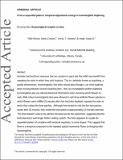Files in this item
From a sequential pattern, temporal adjustments emerge in hummingbird traplining
Item metadata
| dc.contributor.author | Tello-Ramos, Maria Cristina | |
| dc.contributor.author | Hurly, T. Andrew | |
| dc.contributor.author | Healy, Susan D. | |
| dc.date.accessioned | 2020-03-24T00:33:06Z | |
| dc.date.available | 2020-03-24T00:33:06Z | |
| dc.date.issued | 2019-03-24 | |
| dc.identifier | 257337988 | |
| dc.identifier | 7b14e042-1fd8-4b5c-83e2-a8cde3551426 | |
| dc.identifier | 85063284593 | |
| dc.identifier | 000462130200006 | |
| dc.identifier.citation | Tello-Ramos , M C , Hurly , T A & Healy , S D 2019 , ' From a sequential pattern, temporal adjustments emerge in hummingbird traplining ' , Integrative Zoology , vol. 14 , no. 2 , pp. 182-192 . https://doi.org/10.1111/1749-4877.12370 | en |
| dc.identifier.issn | 1749-4877 | |
| dc.identifier.other | RIS: urn:B9782E711B3FD25BA56CDC48E91CDD2D | |
| dc.identifier.other | ORCID: /0000-0002-8059-4480/work/60631328 | |
| dc.identifier.uri | https://hdl.handle.net/10023/19698 | |
| dc.description.abstract | Animals that feed from resources that are constant in space and that refill may benefit from repeating the order in which they visit locations. This is a behavior known as traplining, a spatial phenomenon. Hummingbirds, like other central‐place foragers, use short traplines when moving between several rewarding sites. Here we investigated whether traplining hummingbirds also use relevant temporal information when choosing which flowers to visit. Wild rufous hummingbirds that were allowed to visit 3 artificial flower patches in which flowers were refilled 20 min after they had been depleted repeated the order in which they visited the 3 patches. Although they tended to visit the first 2 patches sooner than 20 min, they visited the third patch at approximately 20‐min intervals. The time between visits to the patches increased across the experiment, suggesting that the birds learned to wait longer before visiting a patch. The birds appeared to couple the sequential pattern of a trapline with temporal regularity, to some degree. This suggests that there is a temporal component to the repeated spatial movements flown by foraging wild hummingbirds. | |
| dc.format.extent | 1148387 | |
| dc.language.iso | eng | |
| dc.relation.ispartof | Integrative Zoology | en |
| dc.subject | Foraging patterns | en |
| dc.subject | Interval timing | en |
| dc.subject | Rufous hummingbirds | en |
| dc.subject | Selasphorus rufus | en |
| dc.subject | QH301 Biology | en |
| dc.subject | QL Zoology | en |
| dc.subject | NDAS | en |
| dc.subject.lcc | QH301 | en |
| dc.subject.lcc | QL | en |
| dc.title | From a sequential pattern, temporal adjustments emerge in hummingbird traplining | en |
| dc.type | Journal article | en |
| dc.contributor.institution | University of St Andrews. School of Biology | en |
| dc.contributor.institution | University of St Andrews. Centre for Biological Diversity | en |
| dc.contributor.institution | University of St Andrews. Institute of Behavioural and Neural Sciences | en |
| dc.contributor.institution | University of St Andrews. Centre for Social Learning & Cognitive Evolution | en |
| dc.identifier.doi | https://doi.org/10.1111/1749-4877.12370 | |
| dc.description.status | Peer reviewed | en |
| dc.date.embargoedUntil | 2020-03-24 |
This item appears in the following Collection(s)
Items in the St Andrews Research Repository are protected by copyright, with all rights reserved, unless otherwise indicated.

